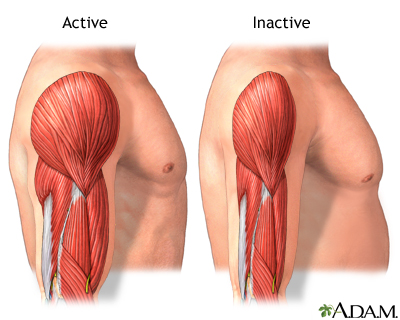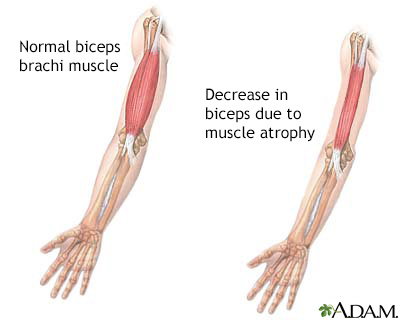Muscle atrophy
Muscle atrophy is the wasting (thinning) or loss of muscle tissue.
Causes
There are three types of muscle atrophy: physiologic, pathologic, and neurogenic.
Physiologic atrophy is caused by not using the muscles enough. This type of atrophy can often be reversed with exercise and better nutrition. People who are most affected are those who:
- Have seated jobs, health problems that limit movement, or decreased activity levels
- Are bedridden
- Cannot move their limbs because of stroke or other brain disease
- Are in a place that lacks gravity, such as during space flights
Pathologic atrophy is seen with aging, starvation, and diseases such as Cushing disease (because of taking too much medicines called corticosteroids or having overactive adrenal glands).
Neurogenic atrophy is the most severe type of muscle atrophy. It can be from an injury to, or disease of a nerve that connects to the muscle. This type of muscle atrophy tends to occur more suddenly than physiologic atrophy.
Examples of diseases affecting the nerves that control muscles:
- Amyotrophic lateral sclerosis (ALS, or Lou Gehrig disease)
Amyotrophic lateral sclerosis
Amyotrophic lateral sclerosis, or ALS, is a disease of the nerve cells in the brain, brain stem and spinal cord that control voluntary muscle movemen...
 ImageRead Article Now Book Mark Article
ImageRead Article Now Book Mark Article - Damage to a single nerve, such as carpal tunnel syndrome
- Guillain-Barré syndrome
Guillain-Barré syndrome
Guillain-Barré syndrome (GBS) is a serious health problem that occurs when the body's defense (immune) system mistakenly attacks part of the peripher...
 ImageRead Article Now Book Mark Article
ImageRead Article Now Book Mark Article - Nerve damage caused by injury, diabetes, toxins, or alcohol
- Polio (poliomyelitis)
Poliomyelitis
Polio is a viral disease that can affect nerves and can lead to partial or full paralysis. The medical name for polio is poliomyelitis.
 ImageRead Article Now Book Mark Article
ImageRead Article Now Book Mark Article - Spinal cord injury
Although people can adapt to muscle atrophy, even minor muscle atrophy causes some loss of movement or strength.
Skeletal muscle - Animation
Regular workouts that include resistance training, such as weight lifting, cause the muscle fibers of skeletal muscle to increase in size and improve overall body tone. Skeletal muscle is a well-organized body tissue, composed in a complex array of smaller and smaller structures. Let’s take a look at a cut-section to see how skeletal muscle is organized. Each skeletal muscle is composed of many units called muscle fascicles. Notice that the fascicles are bound together by a type of connective tissue, which is called fascia. And from that fascicle, we can pull away smaller organizational units called muscle fibers. And from that muscle fiber, we can pull away even smaller strands called myofibrils. Here you can see the myofibrils move as the muscle is contracting. It’s the interaction of these myofibrils as they slide and pull along side each other that gives skeletal muscle its functional ability to do work and move things. Putting it all back together, myofibrils compose muscle fibers, that make-up muscle fascicles, which are grouped together within a skeletal muscle.
Other causes of muscle atrophy may include:
- Burns
Burns
Burns commonly occur by direct or indirect contact with heat, electric current, radiation, or chemical agents. Burns can lead to cell death, which c...
 ImageRead Article Now Book Mark Article
ImageRead Article Now Book Mark Article - Long-term corticosteroid therapy
- Malnutrition
Malnutrition
Malnutrition is the condition that occurs when your body does not get enough nutrients.
 ImageRead Article Now Book Mark Article
ImageRead Article Now Book Mark Article - Muscular dystrophy and other diseases of the muscle
Muscular dystrophy
Muscular dystrophy (MD) is a group of inherited disorders that cause muscle weakness and loss of muscle tissue, which get worse over time.
 ImageRead Article Now Book Mark Article
ImageRead Article Now Book Mark Article - Osteoarthritis
Osteoarthritis
Osteoarthritis (OA) is the most common joint disorder. It is due to aging and wear and tear on a joint.
 ImageRead Article Now Book Mark Article
ImageRead Article Now Book Mark Article - Rheumatoid arthritis
Rheumatoid arthritis
Rheumatoid arthritis (RA) is a disease that leads to inflammation of the joints and surrounding tissues. It is a long-term disease. It can also aff...
 ImageRead Article Now Book Mark Article
ImageRead Article Now Book Mark Article
Home Care
An exercise program may help treat muscle atrophy. Exercises may include ones done in a swimming pool to reduce the muscle workload, and other types of rehabilitation. Your health care provider can tell you more about this.
People who cannot actively move one or more joints can do exercises using braces or splints.
Splints
A splint is a device used to hold a part of the body stable to decrease pain and prevent further injury.

When to Contact a Medical Professional
Contact your provider for an appointment if you have unexplained or long-term muscle loss. You can often see this when you compare one hand, arm, or leg to the other.
What to Expect at Your Office Visit
Your provider will perform a physical examination and ask about your medical history and symptoms, including:
Physical examination
During a physical examination, a health care provider checks your body to determine if you do or do not have a physical problem. A physical examinati...

- When did the muscle atrophy begin?
- Is it getting worse?
- What other symptoms do you have?
The provider will look at your arms and legs and measure muscle size. This may help determine which nerves are affected.
Tests that may be performed include:
- Blood tests
- CT scans
CT scans
A computed tomography (CT) scan is an imaging method that uses x-rays to create pictures of cross-sections of the body. Related tests include:Abdomin...
 ImageRead Article Now Book Mark Article
ImageRead Article Now Book Mark Article - Electromyography (EMG)
Electromyography
Electromyography (EMG) is a test that checks the health of the muscles and the nerves that control the muscles.
 ImageRead Article Now Book Mark Article
ImageRead Article Now Book Mark Article - MRI scans
MRI scans
A magnetic resonance imaging (MRI) scan is an imaging test that uses powerful magnets and radio waves to create pictures of the body. It does not us...
 ImageRead Article Now Book Mark Article
ImageRead Article Now Book Mark Article - Muscle or nerve biopsy
Muscle
A muscle biopsy is the removal of a small piece of muscle tissue for examination.
 ImageRead Article Now Book Mark Article
ImageRead Article Now Book Mark ArticleNerve biopsy
A nerve biopsy is the removal of a small piece of a nerve for examination.
 ImageRead Article Now Book Mark Article
ImageRead Article Now Book Mark Article - Nerve conduction studies
Nerve conduction studies
Nerve conduction velocity (NCV) is a test to see how fast electrical signals move through a nerve. This test is done along with electromyography (EM...
 ImageRead Article Now Book Mark Article
ImageRead Article Now Book Mark Article - X-rays
- Diagnostic muscle ultrasound
Treatment may include physical therapy, ultrasound therapy and, in some cases, surgery to correct a contracture.
Contracture
A contracture develops when normally stretchy (elastic) tissues are replaced by nonstretchy (inelastic) fiber-like tissue. This tissue makes it hard...

Reviewed By
Joseph V. Campellone, MD, Department of Neurology, Cooper Medical School at Rowan University, Camden, NJ. Review provided by VeriMed Healthcare Network. Also reviewed by David C. Dugdale, MD, Medical Director, Brenda Conaway, Editorial Director, and the A.D.A.M. Editorial team.
Ball JW, Dains JE, Flynn JA, Solomon BS, Stewart RW. Musculoskeletal system. In: Ball JW, Dains JE, Flynn JA, Solomon BS, Stewart RW, eds. Seidel's Guide to Physical Examination. 10th ed. St Louis, MO: Elsevier; 2023:chap 22.
Selcen D. Muscle diseases. In: Goldman L, Cooney KA, eds. Goldman-Cecil Medicine. 27th ed. Philadelphia, PA: Elsevier; 2024:chap 389.



 All rights reserved.
All rights reserved.